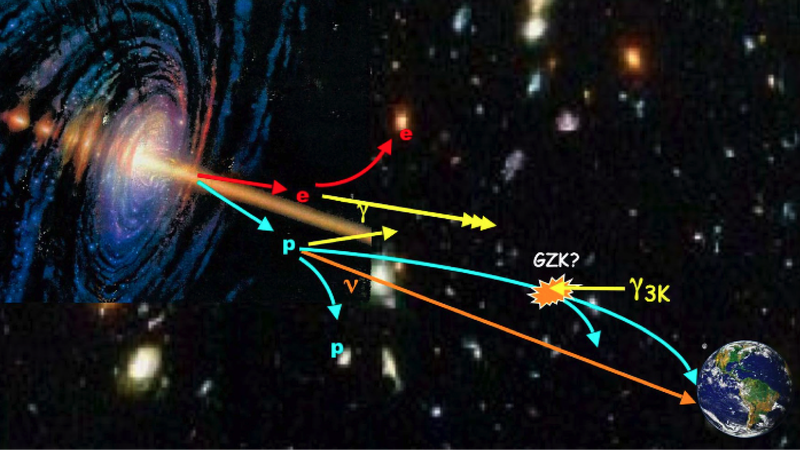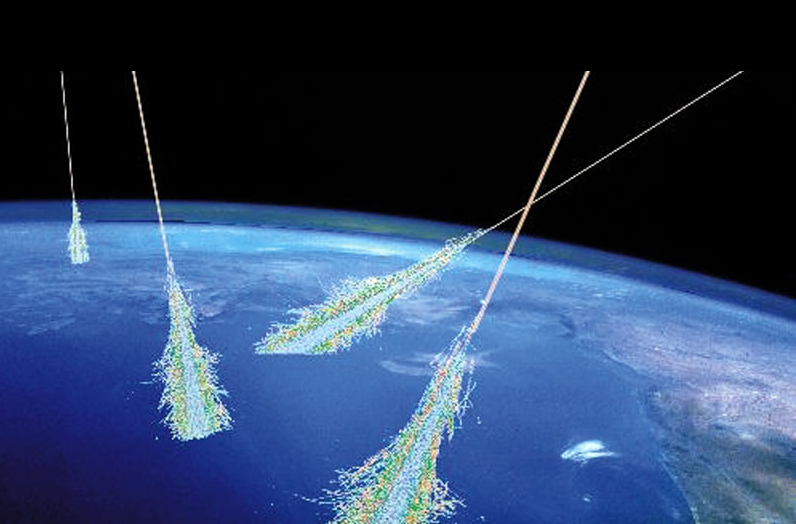Sources of the Ultra-High Energy Cosmic Particles
Ultra-high energy cosmic rays (UHECR) are particles which arrive to Earth from space, with the highest energies ever detected. Their particle identities and sources are as yet unknown, and, at the highest energies, less than one particle per millennium hits a square kilometer of the Earth’s surface, so the UHECR can only be detected through their interaction with the Earth’s atmosphere. In collision with molecules of air they create extensive air showers of charged energetic particles that almost simultaneously hit the ground, covering an area of tens of square kilometers. Since 1999 we are involved in the Pierre Auger Collaboration. To detect the UHECRs the Pierre Auger Collaboration operates a vast observatory stretching over some 3000 square kilometers of pampa in Argentina’s Mendoza province and that is capable of measuring incoming directions, rates and energies of the UHECRs. Our center is involved in data analysis and interpretation, development and management of atmospheric monitoring sites, development of the distributed GRID computing system and studies of the effect of the cosmic magnetic fields on the UHECR trajectories.
Active Galactic Nuclei
Recent measurement results favor conventional scenarios of the production of ultra-high energy (UHE, ≥ 10 EeV) cosmic rays (CRs) at astrophysical sites. Prominent jet outflows in powerful active galactic nuclei (AGN) provide suitable conditions for charged particle acceleration up to UHEs, and are thus considered prime contributors to the observed UHECR flux. During CR acceleration, hadronic interactions occur where photons and neutrinos are produced. As neutral messengers, they provide information about the CR source location in the sky, and the physical conditions at the CR production site, while the charged CRs suffer from loss of directional information by deflections in cosmic magnetic fields.
In a joint research performed with colleagues from University of Innsbruck (Austria) and international partners from Italy (Astronomical Observatory of Brera/INAF) and Poland (University of Lodz), we developed a dedicated method with the goal to determine to which extent UHECRs originate from jetted active galactic nuclei. To reach this goal, we employed a multi-messenger (MM), multi-wavelength (MWL) approach including measurements of 1) UHECRs by the Pierre Auger Observatory, 2) gamma-rays of high- (HE, ≥ 100 MeV), by the LAT detector onboard Fermi Gamma-ray Space Telescope, and very-high energy (VHE, ≥ 30 GeV), by ground-based detectors, and 3) VHE neutrinos by the IceCube experiment.

In the multistep procedure we employed, nearby (< 200 Mpc) AGN were first classified according to their capability to accelerate particles to UHEs. For this purpose, MWL measurements of the AGN electromagnetic spectra were combined with emission models to build a list of suitable AGN candidates for UHECR acceleration. At this research step, we have demonstrated that the recently discovered, relatively low-luminosity, but numerous Fanaroff-Riley type 0 jetted AGN (FR0 radio galaxies) are likely candidates for contributing to the cosmic-ray flux up to the highest energies.
Pierre Auger Observatory data indicate that the CR flux composition at extreme energies trends from light towards intermediate mass nuclei. Consequently, current state-of-the-art AGN emission models have been extended by the Austrian research team to include injection, transport and radiative losses of particle distributions of heavy nuclei composition. The Slovenian research team developed and performed subsequent simulations of UHECR propagation from FR0 galaxies to Earth for various cosmic magnetic field configurations. The resulting UHECR energy spectrum nad mass composition patterns expected at Earth were cross-correlated with the measurements done by the Pierre Auger Observatory and the Telescope Array , which allowed us to estimate the mass composition and energy spectra of UHECRs originating from FR0 galaxies for energies above 1018.6 eV. Photon and neutrino emission signatures were also predicted, and their relation to MM data was investigated. Finally, characteristic UHECR features stemming from AGN jets, which are verifiable by the near-future Cherenkov Telescope Array Observatory (CTAO), were evaluated. The published results of the first comprehensive study of recently discovered FR0 radio galaxies as sources of extreme-energy particles, along with other results of our international collaboration, represent an important steptowards the identification of UHECR sources.”

